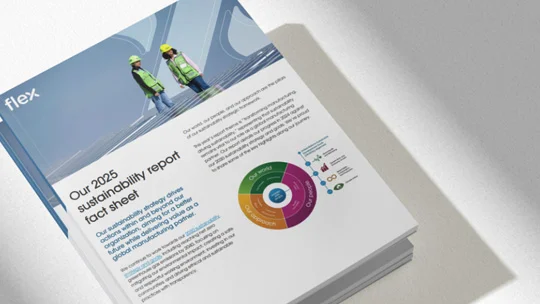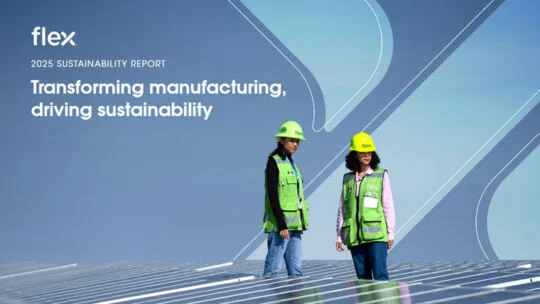
Das Sammeln von Nachhaltigkeitsdaten für den internen Gebrauch – sei es zur Festlegung aktueller Aktivitäten, zur Festlegung zukünftiger Ziele oder zur Messung des Fortschritts – ist ein wertvolles Unterfangen. Die Entwicklung eines soliden Offenlegungsansatzes, der diese Informationen validiert und in einem verständlichen Format mit Stakeholdern teilt, hebt ein Nachhaltigkeitsprogramm jedoch auf die nächste Ebene.

Es kann verständlicherweise Bedenken geben, Nachhaltigkeitsdaten zu teilen, insbesondere bei Organisationen, die ihre Ziele noch nicht erreicht haben. Eine kontinuierliche Berichterstattung zeigt jedoch, dass sie ihren Verpflichtungen nachkommen und schafft Vertrauen bei wichtigen Stakeholdern.
Da Nachhaltigkeit für Verbraucher, Mitarbeiter und Investoren gleichermaßen eine immer größere Priorität erlangt, benötigen Unternehmen zudem einen soliden Rahmen für die Berichterstattung, um den neuen gesetzlichen Anforderungen gerecht zu werden und dem wachsenden öffentlichen Verlangen nach Unternehmenstransparenz gerecht zu werden.
Wählen Sie ein Berichtsframework aus
Die Auswahl mindestens eines Berichtsrahmens, der den Anforderungen der Stakeholder entspricht, ist entscheidend. Viele Unternehmen weltweit verlassen sich derzeit auf zwei etablierte Standards zur Messung und Berichterstattung von Nachhaltigkeitskennzahlen.Die Global Reporting Initiative(GRI) und dieAusschuss für Nachhaltigkeits-Rechnungslegungsstandards(SASB) bieten umfassende Rahmenbedingungen und Leitlinien für die Nachhaltigkeitsberichterstattung.
Die Verwendung von GRI und/oder SASB als Berichtsrahmen gewährleistet methodische Konsistenz über Organisationen und Branchen hinweg. Dies stellt auch sicher, dass die wichtigsten Leistungsindikatoren (KPIs) den gängigen Kennzahlen zur Messung der Auswirkungen von Nachhaltigkeitsinitiativen entsprechen.
Obwohl die Unterschiede zwischen den beiden Standards zahlreich und nuanciert sind, sollten Unternehmen, die sich zwischen GRI oder SASB entscheiden, die ursprüngliche Frage im Hinterkopf behalten: Wer sind die Stakeholder?
GRI eignet sich für private Unternehmen, die in erster Linie an der Offenlegung gegenüber Kunden und Mitarbeitern interessiert sind. GRI ist eine internationale Organisation mit über zwanzig Jahren Erfahrung im Bereich der Nachhaltigkeitsberichterstattung. Die GRI-Standards sind umfassender angelegt und tragen dazu bei, eine solide Grundlage für allgemein anerkannte und konsistente Nachhaltigkeitskennzahlen zu schaffen.
Für börsennotierte Unternehmen kommen die SASB-Standards einem breiteren Spektrum von Interessengruppen entgegen. Im Gegensatz zum GRI-Rahmenwerk konzentriert sich SASB auf finanziell wesentliche Themen, die für Investoren und Aktionäre von Interesse sind. Diese Kennzahlen geben Aufschluss darüber, wie ein Unternehmen seine Geschäftstätigkeit durch Risikominderung und verantwortungsvolles Ressourcenmanagement langfristig aufrechterhalten kann.
Als wir 2009 mit der Veröffentlichung unserer Nachhaltigkeitsdaten begannen, integrierten wir einige Elemente dieser internationalen Rahmenwerke. 2013 begannen wir jedoch, unseren Bericht an das GRI-Rahmenwerk anzupassen. Unsere anfängliche Datenerfassungsmethode bestand jedoch noch aus der manuellen Eingabe von Daten in eine Tabellenkalkulation. Dieser Prozess entwickelte sich später zu einem robusteren und ausgefeilteren internen System.
Wenn Organisationen auf ihrem Weg zur Nachhaltigkeit weiter voranschreiten, beginnen sie möglicherweise, sowohl GRI als auch SASB zu nutzen, um Offenlegungsrahmen zu gestalten und wesentliche Probleme und Auswirkungen mit wichtigen Stakeholdern zu teilen.
Und da sich die Standards für Nachhaltigkeitsberichte und die Aufsichtsbehörden ändern, werden wir bei Flex unseren Ansatz weiterentwickeln. So haben sich beispielsweise in den letzten Jahren die Anleger zunehmend für dieTask Force für klimabezogene finanzielle Offenlegungen(TCFD), die Empfehlungen zu den Informationen gibt, die Unternehmen offenlegen sollten, um die Bewertung und Preisgestaltung klimabezogener Risiken zu unterstützen. Wir legen einen Teil der TCFD in unseren jährlichen CDP-Veröffentlichungen zu Klimawandel und Wassersicherheit offen und arbeiten daran, das gesamte Rahmenwerk in unsere Berichterstattungsaktivitäten zu integrieren.
Verweisen Sie auf Ihre Wesentlichkeitsbewertung
Wie in einemvorherigen PostDie Durchführung einer Wesentlichkeitsanalyse ist entscheidend für die Identifizierung und Priorisierung von Nachhaltigkeitsschwerpunkten. Diese wichtige Maßnahme ermittelt auch, welche Nachhaltigkeitskennzahlen für das Unternehmen von entscheidender Bedeutung sind. Sowohl GRI als auch SASB verfügen über integrierte Tools zur Wesentlichkeitsanalyse, die als Orientierung dienen.
Eine Wesentlichkeitsbewertung ermöglicht es Organisationen außerdem, die Datenpunkte zu bewerten und zu bestätigen, die für die Stakeholder am nützlichsten sind.
Einige Beispielfragen, die wir als Grundlage für unsere Berichterstattung verwendet haben, sind:
- Was wird den Investoren die Gewissheit geben, dass unser Unternehmen gut aufgestellt ist, um künftige Klimarisiken zu meistern?
- Wie können wir gegenüber unseren Mitarbeitern Transparenz hinsichtlich Inklusionsbemühungen, Sicherheit und anderen Anliegen der Mitarbeiter gewährleisten und gleichzeitig deren Privatsphäre wahren?
- Was möchten Kunden über die ökologischen und sozialen Auswirkungen ihres Konsumverhaltens wissen?
Die Antworten auf diese Fragen werden dazu beitragen, die Nachhaltigkeitsberichterstattung zu gestalten, zu fokussieren und standardisierte KPIs zu entwickeln. In unseremjährlicher Nachhaltigkeitsbericht, wir legen anhand spezifischer KPIs offen, die an GRI und SASB ausgerichtet sind.
Eine gute Nachhaltigkeitsberichterstattung erfordert Zeit und Ressourcen. Angesichts der steigenden Anforderungen und des zunehmenden Interesses an Nachhaltigkeitsleistungen und -kennzahlen wird der Bedarf an Datenüberprüfung durch Dritte weiter steigen. Es ist wichtig, die Nachhaltigkeitsdaten von einem unvoreingenommenen Experten außerhalb des Unternehmens überprüfen zu lassen, um die Zuverlässigkeit des Datenerhebungsprozesses und die Richtigkeit der Daten zu bestätigen. Dies verleiht der Berichterstattung zusätzliche Glaubwürdigkeit und schafft Vertrauen in die zukünftige Vorgehensweise.
Eine Warnung vor ungünstigen Ergebnissen
Das Konzept der Nachhaltigkeitsberichterstattung hat sich im letzten Jahrzehnt deutlich verändert. Nachhaltigkeitsberichte sind nicht mehr nur ein Forum für Unternehmen, positive Geschichten über ihre Umwelt- und gesellschaftlichen Aktivitäten zu teilen. Wohlfühlgeschichten sind kein echter Maßstab für Nachhaltigkeitsleistung.
Es versteht sich von selbst, dass Unternehmen manchmal nicht die besten Nachhaltigkeitsdaten vorlegen können. Beispielsweise verbraucht einer ihrer Standorte möglicherweise mehr Wasser als gewünscht, oder es sind noch keine nennenswerten Fortschritte bei der Erreichung eines Arbeitspraktikenziels erzielt worden.
Bedeutet dies, dass Organisationen sich einfach dafür entscheiden können, die Daten nicht zu melden?
Die Antwort lautet: Nein: Sobald ein fester Rahmen und die Verpflichtung zur Berichterstattung anhand bestimmter KPIs vorhanden sind, müssen Unternehmen Transparenz priorisieren und dürfen sich nicht scheuen, die ganze Geschichte zu erzählen, auch wenn bestimmte Ziele verfehlt werden.
Hier sollten Unternehmen einen Aktionsplan veröffentlichen. Nachhaltigkeitsberichte ermöglichen es Unternehmen, ihre Leistung zu bewerten, Verbesserungspotenziale zu identifizieren und dann entschlossene Maßnahmen zur Behebung bestehender Probleme zu ergreifen. Ohne Messung gibt es keinen Fortschritt. Wenn Unternehmen noch nicht dort sind, wo sie hinwollen, hilft die Erhebung und Veröffentlichung von Nachhaltigkeitsdaten dabei, eine Grundlage für zukünftige Ziele zu schaffen und einen Plan zu entwickeln.
Ein definierter Aktionsplan sorgt dafür, dass Unternehmen ihre Verantwortung wahrnehmen und gleichzeitig stetige Fortschritte erzielen, selbst bei weitreichenden Zielen. Vertrauensbildung, die effektive Kommunikation von Nachhaltigkeitsdaten und die Darstellung eines Plans zur Zielerreichung machen den Stakeholdern klar, dass aktuelle Offenlegungen zwar Teil des Nachhaltigkeitsprozesses sind, aber keineswegs das Ziel.
Die Zukunft der Nachhaltigkeitsberichterstattung
Die Nachhaltigkeitsberichterstattung entwickelt sich stetig weiter, ist aber keine vorübergehende Modeerscheinung. Wichtig ist auch, die EU-Taxonomie für nachhaltige Aktivitäten, die Verordnung über nachhaltigkeitsbezogene Offenlegungspflichten im Finanzdienstleistungssektor (SFDR) und die UN-Leitprinzipien für Wirtschaft und Menschenrechte im Auge zu behalten. Darüber hinaus wird die Richtlinie zur Nachhaltigkeitsberichterstattung von Unternehmen (CSRD) die Anforderungen an die Nachhaltigkeitsberichterstattung in der gesamten Europäischen Union verbessern und erweitern. Sie verpflichtet ein breiteres Spektrum von Unternehmen, umfassendere und finanziell relevantere Informationen offenzulegen.
Die Nachfrage nach mehr Transparenz bei Nachhaltigkeitsdaten und -initiativen ist deutlich gestiegen. Weltweit werden Nachhaltigkeitsangaben mit der Zeit immer gängiger und standardisierter. Investoren, Kunden und Mitarbeiter können dadurch die Leistung von Unternehmen im Vergleich zu Wettbewerbern leichter messen.
Neben GRI und SASB nutzen Investoren mittlerweile auch Nachhaltigkeitsratingagenturen – darunter Institutional Shareholder Services ESG (ISS ESG), Morgan Stanley Capital International (MSCI) und Standard & Poor’s Global (S&P Global) – zur Bewertung von Unternehmen in ihren Fonds und Portfolios. Investoren und Kunden berücksichtigen zudem die CDP-Richtlinien zu Klima, Wasser und Lieferkette. Unternehmen weltweit werden aufgefordert, ihre Nachhaltigkeitsdaten strenger und häufiger zu veröffentlichen, und wir beobachten bereits, dass Unternehmen diese Informationen in ihre Jahresberichte für die Aktionäre integrieren.
Unternehmen sollten bei der Entwicklung ihres Offenlegungsrahmens sorgfältig und gründlich vorgehen und schrittweise vorgehen. Ein häufiger Fehler besteht darin, davon auszugehen, dass der Prozess schnell vorangeht. Tatsächlich kann es jedoch oft drei bis fünf Jahre dauern, bis ein Nachhaltigkeitsbericht veröffentlicht und die Offenlegung gemäß anerkannter Rahmenwerke umfassend sichergestellt ist.
Die Offenlegung von Nachhaltigkeitsdaten ist möglicherweise nicht immer ein angenehmer oder unkomplizierter Prozess, aber für Unternehmen, die in einer Welt erfolgreich sein wollen, in der die Stakeholder in den Aufbau einer nachhaltigen Zukunft investieren, ist sie eine wichtige Praxis.





